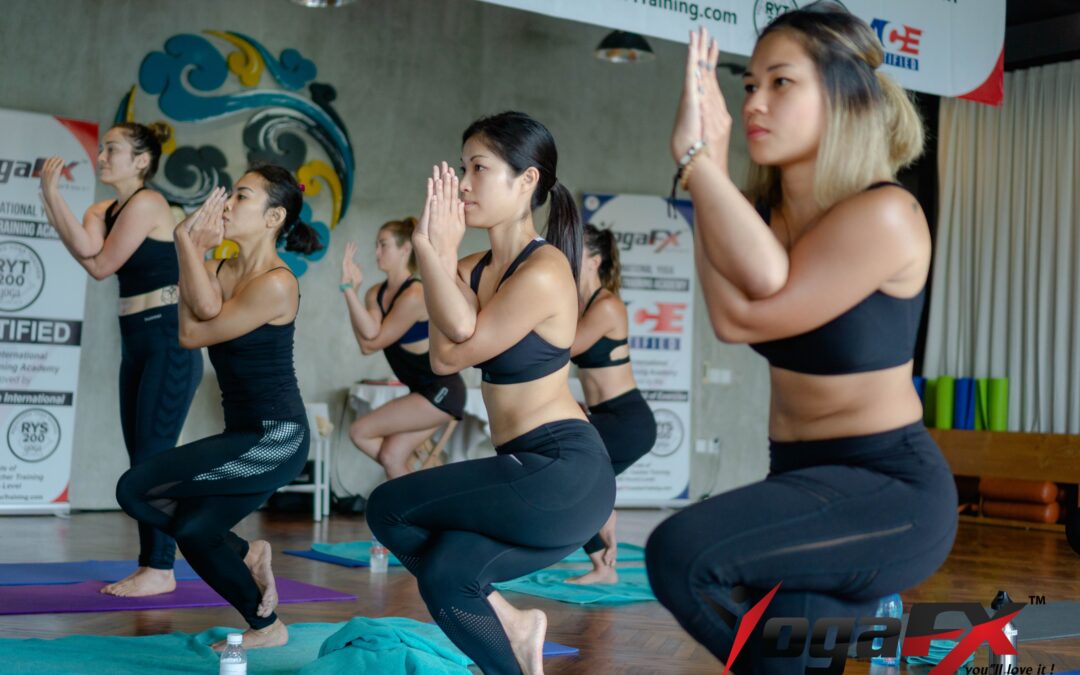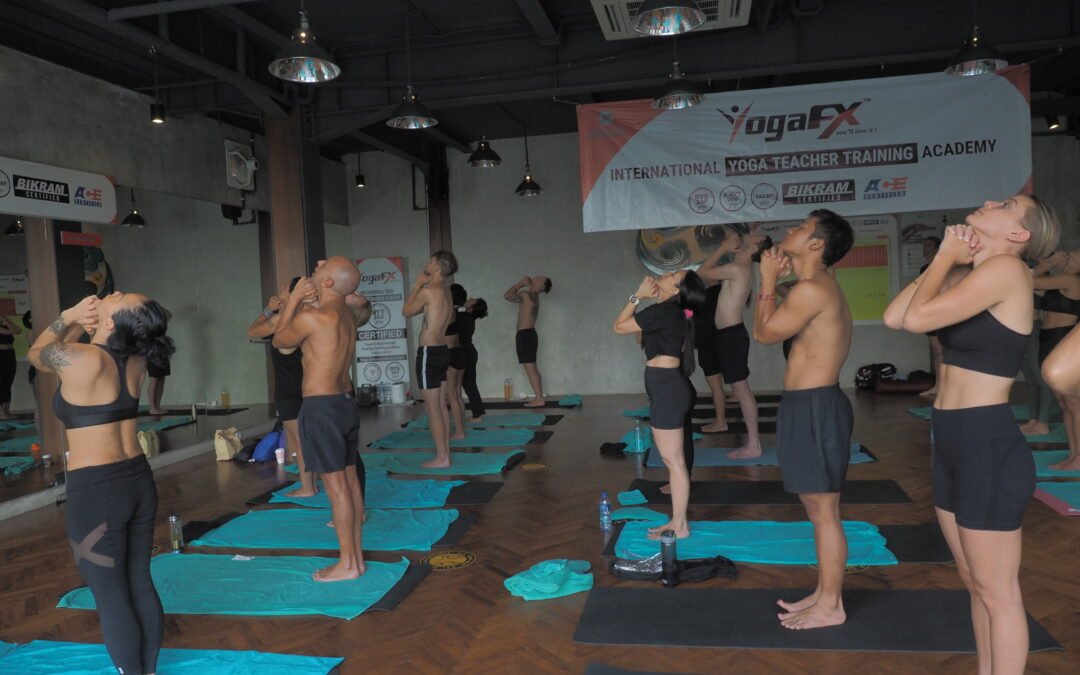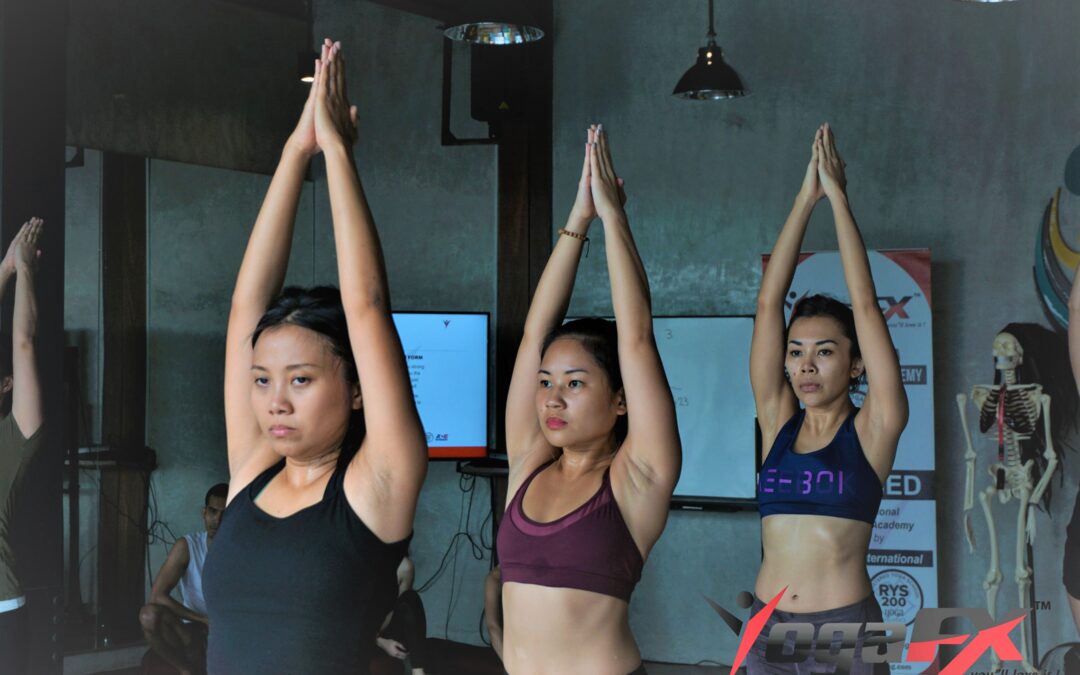Before you begin doing the actual Bikram Yoga poses, start by doing the Standing Deep Breathing pose, also called the Pranayama.
This will help you expand your lungs, improve detoxification of the organs, and increase mental relaxation as well as blood flow, all of these will prove very useful during your Bikram Yoga poses workout.
Bikram Yoga Poses 1 Through 5:
1. Awkward Pose: Utkatasana
 Purposes and Benefits:
Purposes and Benefits:
1. Continues warming up body for all other yoga poses
2. Heals chronically cold feet
3. Circulates fresh blood to knees and ankles
4. Alleviates rheumatism and arthritis in legs
5. Strengthens and firms all muscles of legs and upper arms
6. Increases hip flexibility and relieves muscular aches and cramps
7. Helps to cure slipped discs and other lower-spine problems
How to Do:
More detailed instructions & video here
1. Maintain 6-inch gap between knees and hands while keeping them parallel to floor
2. Ensure that shoulders stay down by relaxing them throughout all 3 stages of this pose
3. Ease exhaustion by focusing on stretching arms out
4. Keep fingers together
5. Breathe at normal pace
2. Eagle Pose: Garurasana
 Purposes and Benefits:
Purposes and Benefits:
1. Works into 12 major joints of body
2. Warms body and readies it for next 3 poses
3. Promotes health of central nervous system
4. Enhances lymphatic functions
5. Improves balance, hip-joint mobility, and immune system
6. Strengthens deltoid, trapezius, and legs
7. Reduces varicose veins
How to Do:
More detailed instructions & video here.
1. Remember to breathe
2. Pull in stomach and keep it away from thighs
3. Position fingers below nose
4. Keep palms together
5. Enter sitting posture and maintain straight spine
6. Squeeze knees and thighs together in all areas that you feel contact between them to increase tourniquet effect
7. Focus body weight onto heel of standing foot and eventually eliminate gap between wrapped foot and back of standing leg
3. Standing Bow-Pulling Pose: Dandayamana Dhanurasana
 Purposes and Benefits:
Purposes and Benefits:
1. Exemplifies “tourniquet” effect in Bikram Yoga because this pose transfers circulation from 1 side of body to other side and then equalizes circulation
2. Improves flexibility and strength of most of body’s muscles
3. Stimulates cardiovascular system
4. Increases circulation to heart and lungs
5. Opens shoulder joints and diaphragm
6. Eases frozen-shoulder conditions
7. Enhances spinal elasticity
8. Firms abdominal wall and upper thighs
9. Tightens buttocks, hips, and upper arms
10. Increases elasticity and size of lungs and rib cage
11. Improves flexibility and strength of lower spine
12. Reduces abdominal fat
How to Do:
More detailed instructions & Video here
1. Grab ankle joint and maintain firm grip using all 5 fingers
2. Bring knees together
3. Raise arm and stretch it toward ceiling
4. Keep knee locked
5. Charge body forward
6. Kick and then feel spine arching backward
7. Visualize foot steadily moving past top of head
4. Balancing Stick Pose: Tuladandasana
 Purposes and Benefits:
Purposes and Benefits:
1. Provides full spinal stress relief
2. Increases cardiovascular circulation, especially to blood vessels of heart
3. Refines control and balance by enhancing physical and mental powers
4. Improves posture
5. Gives many benefits for legs that standing head-to-knee pose also gives
6. Relieves spinal stress
7. Reduces varicose veins
8. Exercises liver, pancreas, spleen, and circulatory and nervous systems
9. May help to clear blocked arteries and to prevent cardiac problems
How to Do:
More detailed instructions & video here.
1. Keep knees locked and stomach in
2. Point toes of non-standing foot
3. Look for front foot in mirror
4. Press arms against ears and remove any arm-to-ear gaps
5. Stretch body toward both sides as though playing tug of war
5. Triangle Pose: Trikanasana
 Purposes and Benefits:
Purposes and Benefits:
1. Stretches both sides of body and revitalizes it
2. Improves every joint, muscle, tendon, and internal organ
3. Opens and increases flexibility of hip joints
4. Provides cardiovascular exercise
5. Reduces saddlebags
6. Helps kidneys, thyroid glands, and adrenal glands
7. Opens shoulder joint and alleviates frozen shoulder
8. Strengthens and tones buttocks and legs
9. Aids in regulating hormonal levels
10. Works all muscle groups simultaneously
11. Finally, this Bikram Yoga pose Mitigates effects of appendicitis, colitis, spondylitis, constipation, low blood pressure, and menstrual disorders
How to Do:
More detailed instructions & videos here.
1. Stretch one arm up and another one down
2. Touch chin exactly to shoulder
3. Keep shoulders down
4. Push both hips toward mirror
5. Touch lowered fingers between 1st toe and 2nd toe
6. Keep torso flat and in a straight line as you stretch arm toward ceiling
7. Avoid letting rib cage stick out
8. Remember to breathe while engaging in positive thoughts and emotions
9. Keep hips down, sit down, and prevent hips from moving up
Bikram yoga is one of the most popular styles of yoga in the world.
Founded by Bikram Choudhury in the 1970s, Bikram yoga consists of 26 yoga asanas and two pranayama exercises that never change. The class is done in a “hot room” which is heated to 105°F (40°C), in order to replicate the temperatures in India.
People who practice Bikram yoga practice these postures and pranayamas in order to stretch and strengthen their bodies and the heated room helps to go deeper into the posture and sweat out toxins. Specifically, Bikram Yoga is often referred to as the 26+2 which makes up the 26 same poses and 2 breathing exercises.
Most poses are performed twice and they’re typically held between 6-60 seconds depending on the pose.
CLICK HERE For More Course Inclusions and Our June Main Event






